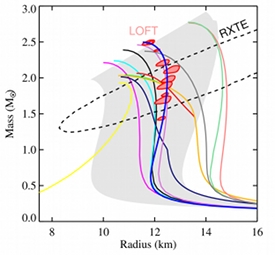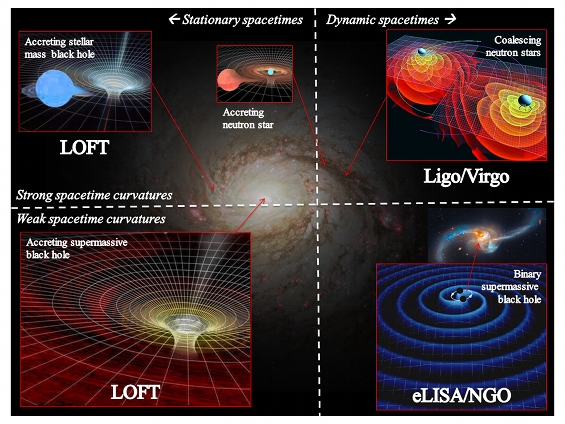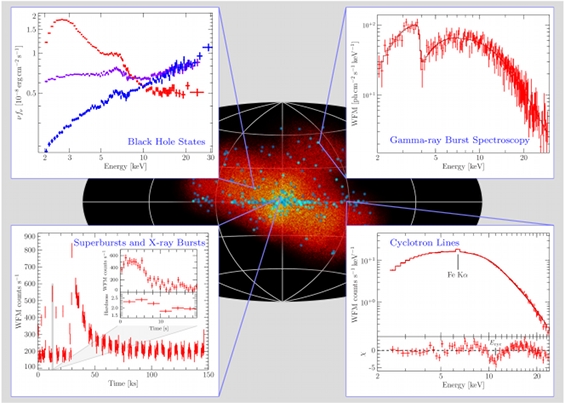Science Goals
Neutron stars and black holes possess the strongest gravitational fields in the Universe. They provide unique opportunities to study a variety of general relativistic effects and hence to investigate gravity in the strong-field regime. This is also an opportunity to measure fundamental parameters of collapsed objects, which is expected to lead to important insights into the physics of matter at supranuclear densities and in supercritical magnetic fields.
The very large collecting area (more than 15 times that of any X-ray mission ever flown) will allow the detection of pulsations and vibrations of neutron stars at enormous signal to noise and thereby perform the first precise measurements of the "equation of state" of supranuclear density matter.
The spectral capability of LOFT, coupled with the enormous throughput (more than 100 times larger than previous instruments with comparable spectral resolution), will characterize the motions of matter close to black holes by several simultaneous orthogonal diagnostics. For example, LOFT will measure changes in spectral features predicted by General Relativity for the emission of a disc of accreting matter around a black hole, on timescales not previously possible.
The neutron star equation of state
Neutron stars are the densest objects in the Universe, attaining physical conditions of matter that cannot be replicated on Earth. Inside neutron stars, the state of matter ranges from ions (nuclei) embedded in a sea of electrons at low densities in the outer crust, through increasingly neutron-rich ions in the inner crust and outer core, to the supranuclear densities reached in the centre, where particles are squeezed together more tightly than in atomic nuclei. Theory predicts a host of possible exotic states of matter, but the nature of matter at such extreme densities is one of the great unsolved problems in modern science, and this makes neutron stars unparalleled laboratories for nuclear physics.
The most fundamental macroscopic diagnostic of dense matter interactions is the pressure-density-temperature relation of bulk matter, the equation of state (EOS).
 |
| Measurements of neutron star masses and radii (red ellipses), will give very tight constraints on the dense matter equation of state. Credit: ESA |
Measuring the EOS of supranuclear density matter is of major importance to fundamental physics. It is also critical to astrophysics. The EOS is central to understanding the powerful, violent, and enigmatic objects that are neutron stars. Mergers between neutron stars or with black holes are prime sources of gravitational waves and the likely engines of gamma-ray bursts. The EOS affects black hole formation timescales, the precise gravitational wave signals, and the process of nucleosynthesis during supernova explosions. The relation between the neutron star's mass and radius is a powerful probe of the EOS. The tools devised to constrain the mass and radius are based primarily on accurate time-resolved and high-throughput broadband spectral measurements.
LOFT will measure the masses and radii of accreting millisecond pulsars to an accuracy of <5 per cent by modelling their pulse profiles. For more information, see Determining the equation of state with LOFT.
Strong gravitational fields
LOFT will play a key role in the broad effort to better understand gravity ranging from the very weak effects that dominate on cosmological scales (acceleration and the cosmological constant), laboratory experiments and Solar System tests, to precision measurements of binary millisecond radio pulsars. However, LOFT measures the direct effects of a strong field gravity on the motions of matter, probing strong field gravity in situ, by direct observation of regions within a few Schwarzschild radii of black holes. This is of critical interest to both the physics and astrophysics communities.
The in situ measurements address gross deviations from Newtonian physics, including qualitatively new effects that General Relativity predicts to occur near black holes. Compact objects accreting matter in binary systems display variability arising in, and occurring at, the dynamical timescale of the flows of accreting matter in the innermost regions (in the range of milliseconds). For more information, see Determining strong gravity effects with LOFT.
 |
| The roles of LOFT and gravitational wave observatories in strong gravity research. Credit: ESA |
Additional scientific themes
LOFT will additionally be a powerful tool to study the X-ray variability and spectra of a wide range of objects: The core science goals require notification of interesting changes in emission from neutron stars and black holes, in order to target observations with its Large Area Detector. This is provided by a Wide Field Monitor which continually scans a large patch of sky around the present viewing direction (orange outline in the illustration below). As a by-product, this monitor provides a vast amount of data simultaneously from accreting pulsars and bursters, magnetar candidates (Anomalous X-ray Pulsars and Soft Gamma Repeaters), cataclysmic variables, bright Active Galactic Nuclei, X-ray transients and the early afterglows of Gamma Ray Bursts.
 |
| The potential of the Wide Field Monitor is highlighted by astrophysical events that can be detected during selected pointings performed in the direction of the Galactic Centre (orange field of view is >1/3 of the sky). Credit: ESA. |
